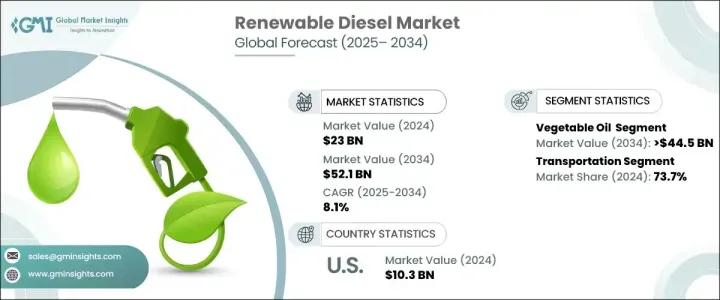
|
시장보고서
상품코드
1699348
재생 디젤 시장 기회, 성장 촉진요인, 산업 동향 분석, 예측(2025-2034년)Renewable Diesel Market Opportunity, Growth Drivers, Industry Trend Analysis, and Forecast 2025-2034 |
||||||
세계의 재생 디젤 시장은 2024년 230억 달러를 기록했고 2025년부터 2034년까지 연평균 복합 성장률(CAGR) 8.1%를 나타낼 것으로 예측됩니다.
세계 산업계와 정부가 기존의 석유 기반 디젤을 대체하고 있으며, 보다 깨끗한 에너지 솔루션의 추진이 이 시장을 계속 견인하고 있습니다. 혼합이 필요한 바이오 디젤과 달리 재생 디젤은 석유 디젤의 직접적인 대체품이며 기존 엔진과 인프라를 개조하지 않고도 사용할 수 있습니다.

기후 변화에 대한 우려가 높아지고 탄소 배출을 대상으로 하는 엄격한 규제가 시장 상황을 더욱 강화하고 있습니다. 농업의 각 분야에서 사업을 전개하는 기업은 지속가능성의 목표에 맞추어 재생 디젤을 사업에 통합하고 있습니다.
| 시장 범위 | |
|---|---|
| 시작 연도 | 2024년 |
| 예측 연도 | 2025-2034년 |
| 시작 금액 | 230억 달러 |
| 예측 금액 | 521억 달러 |
| CAGR | 8.1% |
이 확대를 뒷받침하는 주요 요인 중 하나는 재생 디젤 생산에 있어서의 식물성 기름의 이용 확대이며, 2034년까지 445억 달러를 기록할 것으로 예측되고 있습니다. 이러한 원료는 에너지 밀도가 높고, 재생 디젤은 엔진 출력, 연소 효율, 신뢰성에 있어서 종래의 디젤의 성능을 재현할 수 있습니다.
운수부문은 2024년 시장 점유율 전체의 73.7%를 차지했으며 여전히 지배적인 용도분야입니다. 저탄소 연료에 대한 수요는 기업이 지속가능성에 대한 헌신과 규제 요건을 충족함에 따라 급증하고 있습니다.
북미의 재생 디젤 시장은 2024년에 103억 달러로 평가되어 세계 시장의 47.5%의 점유율을 획득했습니다. 농업에서 건설, 제조에 이르기까지 다양한 산업에서 보다 높은 도입을 촉진하고 있습니다. 또한, 대기업 에너지 기업과 연료 제조업체로부터의 투자에 지지된 이 지역의 생산 능력의 확대는 재생 디젤의 견고한 공급 체인을 키워, 보다 깨끗한 대체 연료로서의 장기적인 생존 가능성을 확실히 하고 있습니다.
목차
제1장 조사 방법과 조사 범위
- 시장의 정의
- 기본 추정과 계산
- 예측 계산
- 1차 조사와 검증
- 시장 정의
제2장 주요 요약
제3장 업계 인사이트
- 업계 에코시스템
- 규제 상황
- 업계에 미치는 영향요인
- 성장 촉진요인
- 업계의 잠재적 위험 및 과제
- 성장 가능성 분석
- Porter's Five Forces 분석
- PESTEL 분석
제4장 경쟁 구도
- 서론
- 전략 대시보드
- 혁신과 지속가능성의 전망
제5장 시장 규모와 예측 : 원료별(2021-2034년)
- 주요 동향
- 동물성 지방
- 식물성 기름
- 기타
제6장 시장 규모와 예측 : 용도별(2021-2034년)
- 주요 동향
- 운송
- 발전
- 기타
제7장 시장 규모와 예측 : 지역별(2021-2034년)
- 주요 동향
- 북미
- 미국
- 캐나다
- 유럽
- 독일
- 프랑스
- 스페인
- 영국
- 이탈리아
- 아시아태평양
- 중국
- 인도
- 인도네시아
- 호주
- 중동 및 아프리카
- 사우디아라비아
- 남아프리카
- 라틴아메리카
- 브라질
- 아르헨티나
제8장 기업 프로파일
- BP
- Chevron
- Diamond Green Diesel
- Eni
- Gevo
- Marathon Petroleum
- Neste
- PBF Energy
- Repsol
- Shell
- Valero
- World Energy
The Global Renewable Diesel Market was valued at USD 23 billion in 2024 and is projected to grow at a CAGR of 8.1% between 2025 and 2034. The push for cleaner energy solutions continues to drive this market as industries and governments worldwide seek alternatives to conventional petroleum-based diesel. Renewable diesel offers significant environmental benefits, including lower greenhouse gas emissions and reduced carbon footprints, making it a preferred choice in the transition toward sustainable fuel sources. Unlike biodiesel, which requires blending, renewable diesel is a direct substitute for petroleum diesel and can be used without modifying existing engines or infrastructure. This advantage is accelerating its adoption across multiple sectors, particularly in transportation, logistics, and heavy-duty applications.

Growing concerns over climate change and stringent regulations targeting carbon emissions are further strengthening the market landscape. Governments across the United States, Canada, and Europe are implementing policies that incentivize the production and use of renewable diesel through tax credits, subsidies, and low-carbon fuel mandates. Additionally, companies operating in transportation, construction, and agriculture are integrating renewable diesel into their operations to align with sustainability goals. The rising demand for carbon-neutral alternatives from both corporate fleets and municipal transit agencies is expected to reinforce market growth over the next decade.
| Market Scope | |
|---|---|
| Start Year | 2024 |
| Forecast Year | 2025-2034 |
| Start Value | $23 Billion |
| Forecast Value | $52.1 Billion |
| CAGR | 8.1% |
One of the primary factors propelling this expansion is the increasing utilization of vegetable oils in renewable diesel production, which is projected to generate USD 44.5 billion by 2034. Vegetable oils, including soybean oil, canola oil, and palm oil, offer a renewable and biodegradable feedstock option that enhances fuel efficiency while significantly cutting down emissions. These feedstocks have high energy density, allowing renewable diesel to replicate the performance of traditional diesel in terms of engine power, combustion efficiency, and reliability. As industries strive for cleaner fuel options that do not compromise on operational performance, the use of vegetable oils as key feedstocks is gaining momentum.
The transportation sector remains the dominant application segment, accounting for 73.7% of the total market share in 2024. The rising adoption of renewable diesel by logistics providers, public transit systems, and heavy-duty fleets is driven by its ability to maintain vehicle performance while reducing emissions. The demand for low-carbon fuels in commercial transport is surging as companies respond to sustainability commitments and regulatory requirements. With growing emphasis on ESG (Environmental, Social, and Governance) policies, fleet operators are increasingly investing in renewable diesel to future-proof their operations.
North America renewable diesel market was valued at USD 10.3 billion in 2024, capturing a 47.5% share of the global market. This share is expected to rise by 2034, supported by progressive government initiatives like the Renewable Fuel Standard (RFS) and the Low Carbon Fuel Standard (LCFS). These policies are driving higher adoption across multiple industries, from transportation and agriculture to construction and manufacturing. The region's expanding production capacity, backed by investments from major energy companies and fuel producers, is also fostering a robust supply chain for renewable diesel, ensuring its long-term viability as a cleaner fuel alternative.
Table of Contents
Chapter 1 Methodology & Scope
- 1.1 Market definitions
- 1.2 Base estimates & calculations
- 1.3 Forecast calculation
- 1.4 Primary research & validation
- 1.4.1 Primary sources
- 1.4.2 Data mining sources
- 1.5 Market definitions
Chapter 2 Executive Summary
- 2.1 Industry synopsis, 2021 – 2034
Chapter 3 Industry Insights
- 3.1 Industry ecosystem
- 3.2 Regulatory landscape
- 3.3 Industry impact forces
- 3.3.1 Growth drivers
- 3.3.2 Industry pitfalls & challenges
- 3.4 Growth potential analysis
- 3.5 Porter's analysis
- 3.5.1 Bargaining power of suppliers
- 3.5.2 Bargaining power of buyers
- 3.5.3 Threat of new entrants
- 3.5.4 Threat of substitutes
- 3.6 PESTEL analysis
Chapter 4 Competitive landscape, 2024
- 4.1 Introduction
- 4.2 Strategic dashboard
- 4.3 Innovation & sustainability landscape
Chapter 5 Market Size and Forecast, By Feedstock, 2021 – 2034 (USD Billion & MT)
- 5.1 Key trends
- 5.2 Animal fat
- 5.3 Vegetable oil
- 5.4 Others
Chapter 6 Market Size and Forecast, By Application, 2021 – 2034 (USD Billion & MT)
- 6.1 Key trends
- 6.2 Transportation
- 6.3 Power generation
- 6.4 Others
Chapter 7 Market Size and Forecast, By Region, 2021 – 2034 (USD Billion & MT)
- 7.1 Key trends
- 7.2 North America
- 7.2.1 U.S.
- 7.2.2 Canada
- 7.3 Europe
- 7.3.1 Germany
- 7.3.2 France
- 7.3.3 Spain
- 7.3.4 UK
- 7.3.5 Italy
- 7.4 Asia Pacific
- 7.4.1 China
- 7.4.2 India
- 7.4.3 Indonesia
- 7.4.4 Australia
- 7.5 Middle East & Africa
- 7.5.1 Saudi Arabia
- 7.5.2 South Africa
- 7.6 Latin America
- 7.6.1 Brazil
- 7.6.2 Argentina
Chapter 8 Company Profiles
- 8.1 BP
- 8.2 Chevron
- 8.3 Diamond Green Diesel
- 8.4 Eni
- 8.5 Gevo
- 8.6 Marathon Petroleum
- 8.7 Neste
- 8.8 PBF Energy
- 8.9 Repsol
- 8.10 Shell
- 8.11 Valero
- 8.12 World Energy



















